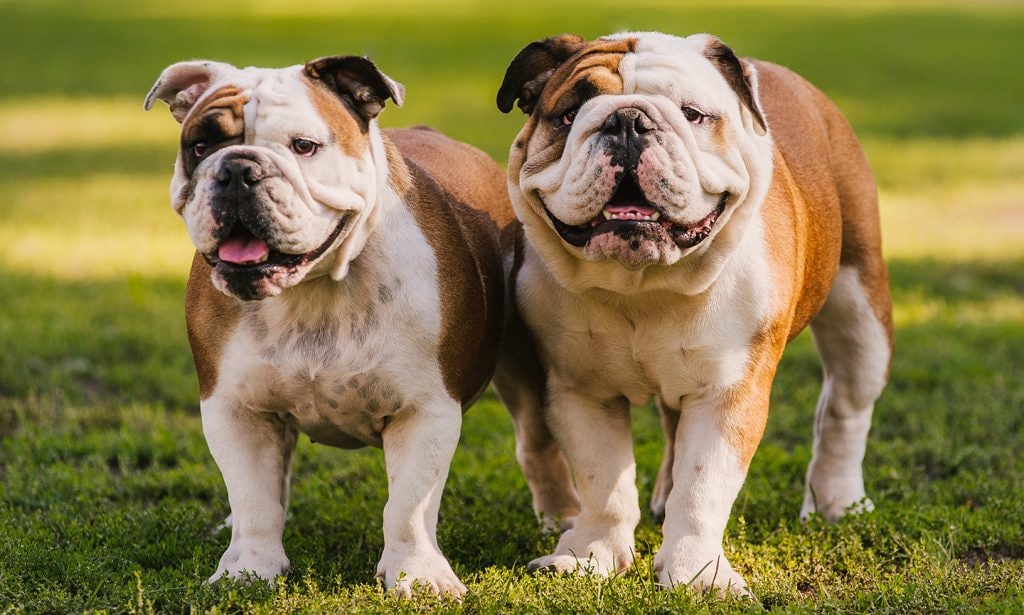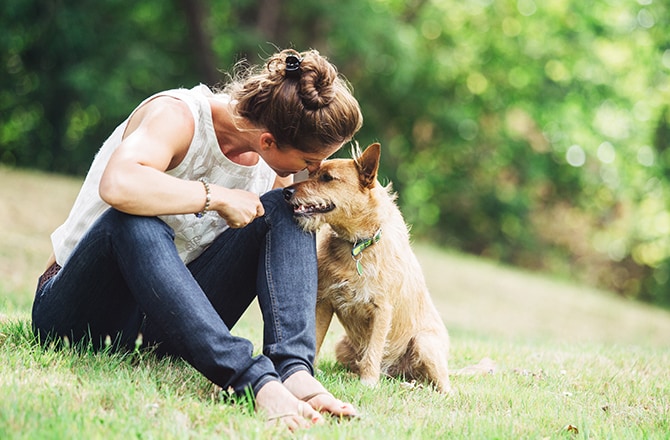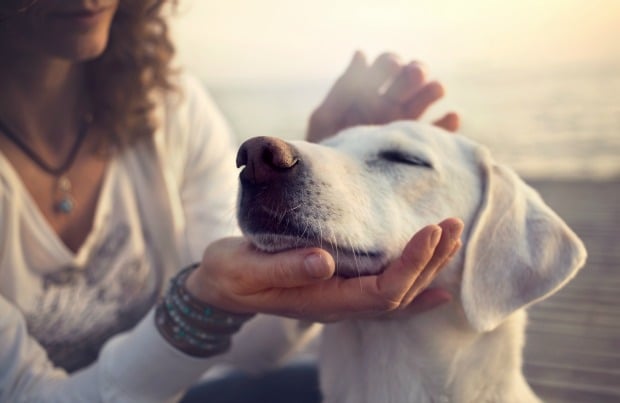Pet greetings can be a complicated business, especially when introducing dogs and humans. Some pets are fine with meeting strangers, while others might need some lessons in dog socialization before they’re ready for an introduction.
Meeting old friends can be tricky too—some dogs will remember people they’ve met before at the first sniff, but some might need a little time to get reacquainted. So here are some tips on proper dog behavior when introducing dogs to friends.
Remember That Not All Dogs Are the Same
Just like with people, dogs’ reactions to strangers are not a one-size-fits-all. “Some people are huggers—they love engaging with new people and having a tactile experience,” says Paula Nowak, CPDT-KA, CTDI, head trainer and behavior consultant for Canine Country Academy. “Then you have others who never like to hug, have a bigger [personal] space bubble and likely avoid a lot of social interaction.”
The same is true of dog socialization—some pups love interacting with people, while others need time to adjust to new situations. They may be a little suspicious of strangers and need more personal space. “Think of your individual dog to see what kind of people they enjoy interacting with, what they like to do with new people, and how big their world should be,” Nowak says.
Another thing to keep in mind, according to Nowak, is that people are not entitled to pet or interact with your dog. If your dog is uncomfortable meeting people or rushing the introduction phase, you have the right to stop the process and walk away. “Sadly, people believe ‘All dogs love me’ and will try to engage with your dog despite you telling them nicely that the dog is not interested in the interaction,” says Nowak. In those cases, Nowak says it’s perfectly fine to walk away or say something like, “No thank you; my dog is unsure of new people,” to stop them from approaching.
Always Start by Listening to Body Language
Your dog’s body language can tell you heaps about how he’s feeling about meeting a new person. A little wag of the tail might tell you the meeting looks like fun, but to truly understand how your dog is feeling, you have to look at his entire body. “Calming signals are clues into what our dog is saying; these signals may display as yawning, licking their lips, turning their head away and shaking their entire body off as if it were wet,” says Nowak. “Dogs will use these signals to say they mean no harm; they are trying to calm themselves or trying to calm someone else.” These calming tactics are a sign that your pup is distressed or uncomfortable, in which case you should stop the interaction from happening to avoid further stressing your dog.
Dog communication clues can also be found in your dog’s eyes, mouth, joints and posture. For example, Nowak points out that a dog who is unsure of the greeting may display a low or very high posture position. “They will crouch down upon the greeter coming close, or they may puff up, getting really tall; any extremes in their posture and overall behavior can be a clue they are not wanting the interaction,” Nowak explains.
Keep First-Time Meetings Relaxed and Casual
Your dog’s first impression of a person can be affected by things in the environment, so Nowak suggests choosing a neutral environment without additional triggers when introducing dogs to people for the first time.
If you’re meeting indoors, keep your dog on a leash. “The person handling the dog leash needs to be as relaxed as possible since your dog is reading body language to determine if this person is friend or foe,” says Nowak.
Meeting at the door might not be the best idea, though, as tight spaces can create tension. Instead, have the guest come into the living room, where the open space feels more inviting and you have a chance to take it slow. “The more your dog gets to feel like they have a choice in the interaction, the less scary the meeting can be for them,” Nowak says.
Work on Behavior Before the Meeting
You can’t expect your dog to be polite when meeting somebody if you’ve never practiced greetings before. To get started, you can train for proper meeting petiquette right at home, using friends and family members your dog is already familiar with and relaxed around.
A good option is to have your dog sit near you, facing the person he’s about to meet. “You might then say something like, ‘Go say hi!’ and gesture towards the new person,” says Nowak. “The new person can either give the dog a treat (held low to discourage jumping) or gentle petting.”
Repeat this as many times as you need to, but always call your dog away with a treat if he starts to get too excited or jumps up. This is especially important for potential future meetings with children or seniors, where a super excited dog can easily knock over the greeter. You can keep a small handful of treats with you for this.
Reintroducing Dogs to Long-Lost Friends
Chances are your dog will recognize somebody they’ve met before, even if it takes them a little bit of time. “Dogs will use scent, body language, the person’s voice and how they interact to refresh their memory of the person,” says Nowak. “Hopefully their initial interactions were positive, so they can pick up where they left off in their relationship.”
If, for some reason, your pup doesn’t recognize the person, then go back to the basics and start over with the introductions. “The same would be true for a dog who did not enjoy their interaction initially and now is working on a more positive association,” Nowak says.
Don’t Force Your Dog to Socialize
Even if you’re rooting for your pup and a certain person to become fast friends, it’s important that you don’t put either of them in a difficult situation. “Forcing a dog to greet a person they are not comfortable with can make them feel out of control and unsafe, and lose trust in your relationship,” Nowak says.
If you notice body signals or vocalization that might indicate distrust, it might be wise to slow down and take a step back. “Some dogs may bark, lunge, growl, jump up and down, and pull towards the person as if to say, ‘I’ll get you before you get me,'” says Nowak. “They may even try to bite the person if they feel there is no choice to get them to move away.”
Dogs also tell you they’re not up for a meeting in other ways. For example, some dogs might try to hide behind you or between your legs, look away, lie on the ground, or pull on the leash, as if trying to escape.
In the end, dog socialization should be as much of a pleasant experience as possible for both humans and canines. It is important to take the time to work on first impressions and building relationships so you can better create positive interactions between your friends and your pup.
More on petiquette:
Share:











